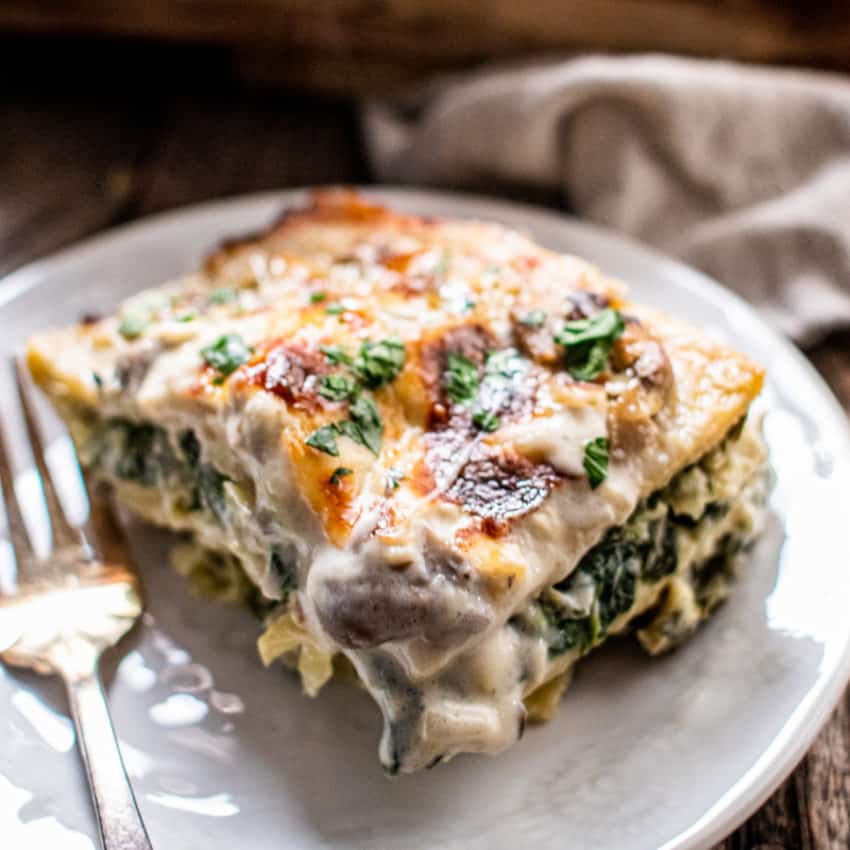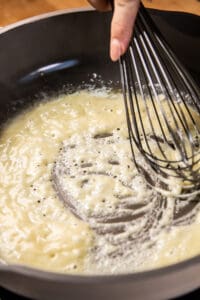How to Make Gluten-Free Roux: it's one of the basics you need to know! This recipe for gluten-free roux also offers a dairy-free version, plus tips & tricks for getting gluten-free roux just right.

Can you make thick, rich gluten-free sauces & gravies? Yes, you can.
This White Lasagna starts with a roux that becomes a creamy mushroom sauce. Who wouldn't want that? Nobody, that's who.
You can use this roux to make your own gluten-free sauces and recipes, or convert conventional favorites, like sausage gravy.
What to use the roux for, and roux colors or "stages"
Roux is used for thickening gravies, soups, sauces - all kinds of delicious things. Many recipes call for a white or blond roux, which simply refers to the color of the mixture as it cooks. Gumbo and a few other dishes call for a "brick" roux (or a dark roux). This just means that the mixture is cooked until it gets brick red- just before it burns!

Pro Tip: don't take gluten-free roux much past the "peanut butter" stage
Because gluten-free flour acts a little differently than wheat flour, I don't recommend making gluten-free roux much darker than peanut butter colored. Going darker than that can result in a burnt or scorched taste, even if the gluten-free roux doesn't look burned. I also don't make the roux in the oven, because I think you really need to keep an eye on it.
Choosing gluten-free flour for roux:
I usually use one of my favorite gluten-free flour blends to make roux, along with butter or olive oil. My favorites are Pamela’s Gluten-Free Artisan Blend or King Arthur Gluten-Free All-Purpose blend (not the King Arthur Measure for Measure blend). Neither of these blends contains dairy- some GF blends do. Also, the Pamela's has limited gum binder, and the recommended King Arthur blend had no gum binder. You can also use a mixture of rice flour and tapioca flour/starch. Our favorite rice four is Mochiko Sweet Rice Flour from Koda Farms.
You want a blend with starches like tapioca, potato or corn, but no or limited gum-binders.
Can you make grain-free roux? Yes.
If you'd like to make your roux grain-free, the best option I've found is using a mixture of cassava flour and tapioca starch.

What do you need to make this roux recipe gluten-free?
Making gluten-free or gluten-free dairy-free roux doesn't take much. Here's what you need:
Supplies:
- heavy duty saucepan or skillet
- whisk
Ingredients:
- butter or olive oil
- gluten-free flour blend -OR- sweet rice flour + tapioca starch
Making dairy-free roux:
You’ll notice I use a little less olive oil than butter when I make dairy-free roux. That’s because the consistency of the oil is different than butter. Roux is usually half butter-half flour, and I've tried all kinds of dairy-free fats and oils. I'm convinced if you need GFDF roux, the scant-olive-oil-way is the best way.
Now you're ready to make gluten-free Bechamel Sauce or one of your other favorites.

Gluten-Free Roux Recipe
Ingredients
- 4 tablespoons butter -OR- 3 ½ tablespoons olive oil
- 4 tablespoons gluten-free flour blend -OR- 2 tablespoons rice flour + 2 tablespoons tapioca flour * for grain-free, use 2 tablespoon cassava flour + 2 tablespoon tapioca flour
Instructions
- In a medium-sized, heavy duty saucepan, heat the butter over medium-low heat until melted (or warm the oil).

- Add the gluten-free flour and whisk until smooth. Over medium heat, cook until the mixture turns a light, golden sandy color (blond roux), about 6 to 7 minutes.

- If desired, reduce heat to medium-low and continue cooking until the mixture turns the color of peanut butter, roughly 4-6 minutes more.

Video

Notes
- Nutrition calculated for one batch of gluten-free roux using butter.
Nutrition
images by Meg van der Kruik

Use your roux to make Gluten-Free Bechamel Sauce/White Sauce:
This Gluten-Free Béchamel Sauce recipe can be made with or without dairy, and it always comes out beautifully.
Frequently asked questions about gluten-free roux:
Yes, but the blend matters. Don't use an all-nut blend or a blend with tons of binders. Our favorites are Pamela’s Gluten-Free Artisan Blend or King Arthur Gluten-Free All-Purpose blend, which has less binders then their Measure for Measure blend. You can also use finely ground sweet rice flour, our favorite is from Koda Farms, with a bit of tapioca starch.
All-nut flours won't thicken the same way as conventional flour or a GF blend. If you want to make a grain free roux, the best bet is to use a blend of arrowroot or tapioca starch and cassava.
The best options to use as a universal cooked thickener like roux are rice flour + tapioca flour or a gluten-free all purpose blend. Arrowroot, cornstarch or tapioca slurries will work if you're trying to thicken a sauce without starting from a roux.
Yes, absolutely. Be sure to use a blend that has some starch and/or binders, Pamela’s Gluten-Free Artisan Blend or King Arthur Measure for Measure blend.
Yes. Use olive in a slightly reduced measurement for the fat, along with a gluten-free flour blend, and an unsweetened plant-based milk if you're making a white sauce or gravy.
Yes. Tapioca flour and tapioca starch are the same product. That is not the case with potato flour/potato starch or corn flour/corn starch/corn meal, so it can be confusing.












Carpenter Dave says
Thank you for the information. You have a typo and a word omission in the first sentence under the heading "Choosing gluten-free flour for roux + making it dairy-free too".
You sound like you really know your stuff but it is a bit hard to take you completely seriously when one has to guess what is trying to be communicated.
Ed says
You're an a$$
Ryan says
Shut the fuck up, Dave.
Brenda Kay says
Totally agree, so uncalled for Dave, we know perfectly well what she is saying. So maybe its just you that has to guess?
Olivia Lind says
So excited I found this! I shared with a friend